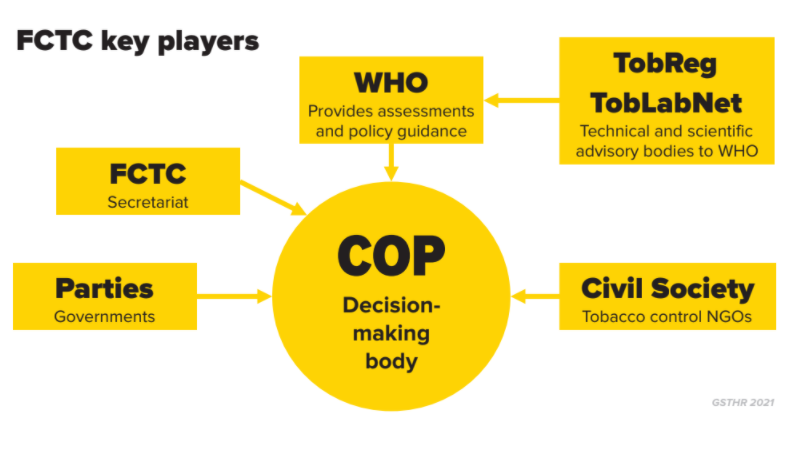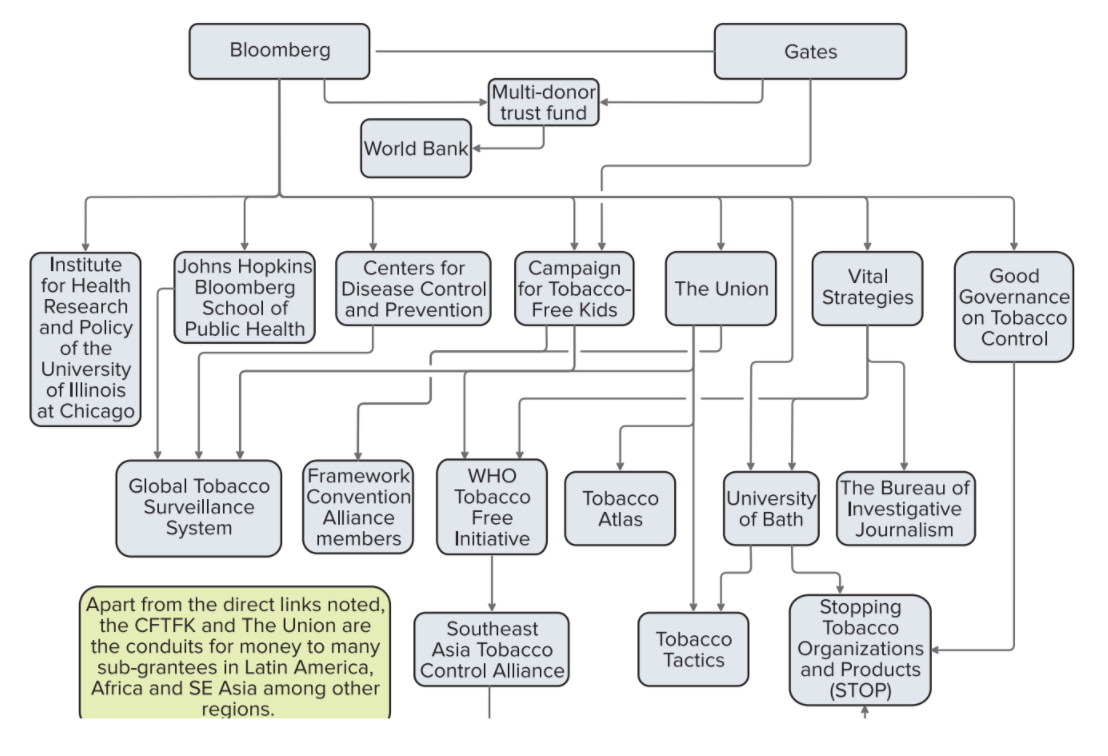The image on the cover of the new report, Fighting The Last War: The Who and International Tobacco Control, is a distillation of that war. On one side is a mass of menacing, angry orange and yellow smoke; on the other, a cool-white cloud of fluorescent vapor. The unmistakable message: Smoke kills, vapor saves.
For readers interested in how international tobacco control groups function on a granular level, one of the first sections deconstructs in plain language the complicated intersectionality of the World Health Organization (WHO), the Conference of the Parties and tobacco control NGOs. The report explains, “The main policy engine driving the international effort to combat the smoking epidemic is the WHO Framework Convention on Tobacco Control (FCTC), which entered into force in 2005. This enabled the creation of the Conference of the Parties (COP), regular meetings which bring together delegations of government representatives who discuss the implementation of FCTC measures.”
The next session of the Conference of the Parties to the WHO FCTC (COP9) takes place in November. Tobacco harm reduction is not explicitly on the agenda, despite loud calls for its adoption.

The tobacco policies the WHO endorses have an enormous influence on countries around the world who look to them for guidance. That, according to Harry Shapiro, the author of Fighting the Last War, is not a good thing. He sketches out in seven short chapters exactly why.
The number of smokers is the same as it was 20 years ago: 1.1 billion worldwide.
The report, launched by the Global State of Tobacco Harm Reduction on October 27 and written with great clarity, drops a statistic that is both mind-blowing and perplexing. The number of smokers is the same as it was 20 years ago: 1.1 billion worldwide.
Clearly, the approach tobacco control organizations have taken for two decades isn’t working. Fighting the Last War explains the reasons for this epic, global failure and there are many bad actors—most critically the WHO.
The reasons the number of smokers remains high, despite all the efforts of tobacco control, are many and complicated by geopolitics. One is that the WHO and its NGO allies insist on continuing to wage a historic battle on dozens of fronts against tobacco companies. It has become a forever war that takes resources and money away from actually helping smokers quit. More recently, nicotine itself has become the enemy, and they have launched a massive disinformation campaign against most forms of safer nicotine products (SNP). Nicotine prohibition is the endgame as the WHO throws its support behind bans of SNP around the world.
Inexplicably, in a world full of cheap, illicit drugs, the agency hasn’t learned the lesson that prohibition of any drug has never succeeded.
Safer nicotine products, the report notes, “…are significantly less risky than combustible tobacco and have a role to play in harm reduction.” Vapes, snus and heated tobacco products are the key to bringing down the staggering rates of smoking, especially in low- and middle-income countries (LMIC), but the WHO adamantly rejects their use. And in an ironic twist, it allows the tobacco companies it so despises to continue selling the products that kill—cigarettes—with far fewer restrictions. It’s a self-fulfilling prophecy.
Fighting the Last War gives several infuriating examples that show the lengths the WHO will go to in order to smear SNP. The agency published a report in July 2021 that for the first time devoted a chapter to SNP. And it was so full of false or misleading information, errors of fact, exaggerations and over-simplifications, it made your head spin. It included this whopper of a lie: “Children and adolescents who used [electronic nicotine delivery systems, like vapes] can double their risk of smoking.”
Every color photo in the 200-page report except one depicted a young child. One appears to show a baby reaching for a vaping device. It’s outrageous! The fact is, the vast majority of people who vape are adults and the WHO knows this. But purporting to keep “the children” safe has always been a key strategy to convince the public to continue drug wars.
In 2019, the prestigious Lancet journal published an article by WHO Director-General Dr. Tedros Adhanom Ghebreyesus. Using cherry-picked, junk science, he asserted that vaping devices produce “toxic emissions,” elevate the risk of heart attack and can cause lung damage, fetal abnormalities and impaired brain development.
The section on the insidious role of Michael Bloomberg and his vehicle Bloomberg Philanthropies is a must-read.
These misrepresentations and outright lies from the physician-leader of an international public health organization—in the face of over a decade of science showing vapes are 95 percent safer than cigarettes, and debunking such dangerous health claims—are stunning. Did Tedros write the article, or Trump? Unfortunately, the WHO is a trusted source of health information. Millions of smokers will accept these claims—and therefore not attempt to switch to SNP.
Fighting the Last War’s section on the insidious role of Michael Bloomberg and his vehicle Bloomberg Philanthropies is a must-read. Shapiro lists and analyzes how funding from the philanthro-capitalist-colonialist has undermined nations’ sovereignty. Bloomberg vociferously opposes SNP, so governments or NGOs that take his money work to enact bans and severely restrict access.
There is a nifty graphic that shows where the Bloomberg (and Bill Gates) billions flow. Among the many recipients: the US Centers for Disease Control and Prevention, The Bureau of Investigative Journalism, WHO Tobacco Free Initiative, University of Bath, Southeast Asia Tobacco Control Alliance and the Campaign For Tobacco-Free Kids (CTFK). Interestingly, Shapiro argues that Bloomberg money saved CTFK from irrelevance and of going out of business.

Fighting The Last War convincingly makes the case that the availability of SNP is the most effective way to drive down the death and disease from smoking, and it is way past time to embrace these innovations.
But the report also raises the question, do the WHO or any of the other organizations in the international tobacco control establishment really want to save the lives of 1.1 billion smokers?
All images from Fighting the Last War, published by the Global State of Tobacco Harm Reduction.
Knowledge-Action Change, which produces the Global State of Tobacco Harm Reduction reports, has provided scholarships and donations to The Influence Foundation, which operates Filter. Filter’s Editorial Independence Policy applies.





Show Comments